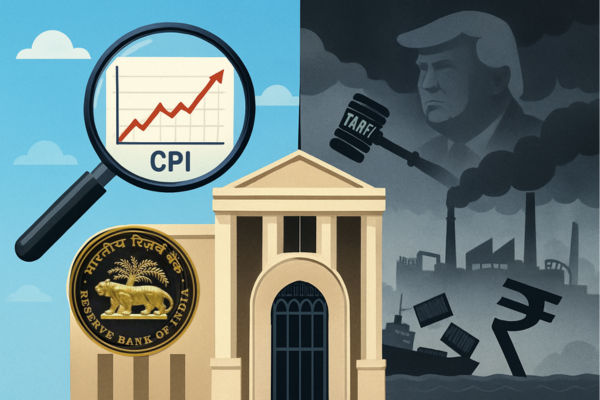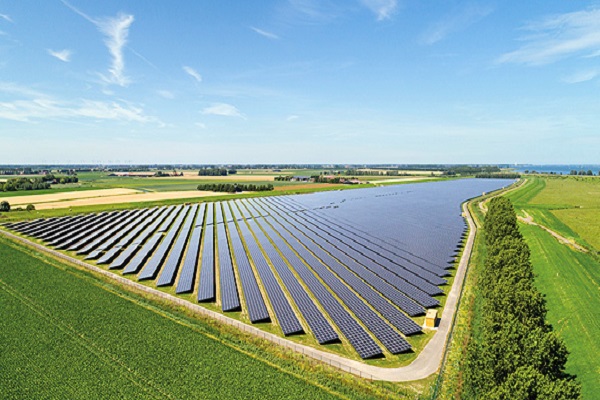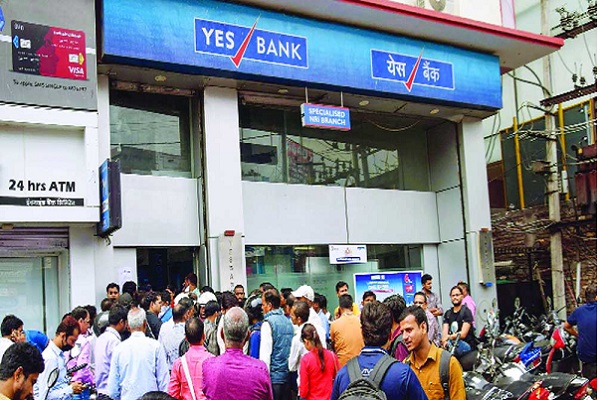.png)

Datametricx is a veteran journalist tallying the macro game, keeping score of the numbers that shape India’s economy and policy.
November 15, 2025 at 1:07 PM IST
India's annual retail price inflation fell to a record low of 0.25% in October from 1.44% in September, driven by lower food prices, recent GST rate cuts, and a high base effect. This is the third time in four months that inflation has remained below the Reserve Bank of India’s 2-6% medium-term target range.
Food inflation also fell sharply, declining to -5.02% in October from -2.33% a month earlier. The data reflect the impact of recent GST rate cuts, particularly in automobiles and consumer durables, with prices of passenger vehicles falling 6.8%, motorcycles and scooters 4.5%, washing machines and television sets 2.6% each, and refrigerators 1.6% month-on-month.
Headline inflation would have turned negative in October if not for the sharp rise in precious metals. Gold and silver prices increased 12.5% and 21.7% month-on-month, respectively. Excluding gold, overall inflation would have been -0.6% in October.
Core inflation, which excludes food and fuel, edged up to a four-month high of 4.4% in October from 4.3%, largely due to the surge in precious metal prices. In contrast, core-core inflation, which also excludes gold, silver, petrol and diesel, fell to a series low of 2.6% from 3.0% in September, indicating that underlying demand conditions remain benign.
Headline inflation is likely to climb from here, with the base effect turning unfavourable from November.
With headline inflation in July-September undershooting the RBI’s projection of 1.8% by 10 basis points and the October-December trajectory running well below the estimate, the central bank’s full-year forecast of 2.6% is also likely to be missed.
However, the RBI’s December monetary policy decision will hinge largely on the July-September GDP data, which will be released a week before the next Monetary Policy Committee meeting in early December. If GDP growth exceeds the RBI’s projection of 7.0% for the quarter, the central bank will face a “nice” dilemma – inflation undershooting and stronger-than-expected growth.
Meanwhile, wholesale price inflation fell to a 27-month low of -1.21% in October from 0.13%, led by base effects and a fall in prices of non-food primary articles. Though the food index remained unchanged on month, wholesale food inflation fell to -5.04% in October — the lowest in the current series — from -1.99% in September.
Non-food manufactured products, or core WPI inflation, fell to 1.5% in October from 1.8% in September. WPI inflation has remained below its retail counterpart since December 2022.
Automobile dispatches to dealers rose to a record in October, though the growth was lacklustre considering the GST rate cuts and festive-season demand. Dispatches of passenger vehicles and two-wheelers were the highest ever in a month, but overall sales grew just 6.3% year-on-year to 2.75 million vehicles.
The passenger vehicle segment performed the best, growing 17.2% year-on-year to 460,739 units. Two-wheeler dispatches grew just 2.1% to 2.21 million vehicles, dragged down by a 4.0% decline in motorcycle sales to 1.34 million units.
The dispatch data stand in contrast to retail automobile sales, which surged 40.5% year-on-year to a record 4.02 million vehicles — the sharpest pace in three years.
Overall, automobile production declined 2.8% year-on-year to 2.80 million vehicles in October, suggesting that companies expect sales to ease in the coming months.
Open-ended mutual fund schemes recorded their highest net inflow in six months in October, driven largely by a surge in debt fund investments. Net inflows stood at ₹2.16 trillion, compared with a net outflow of ₹428 billion in September and an inflow of ₹2.40 trillion a year earlier. Debt-oriented schemes saw inflows of ₹1.60 trillion in October, reversing an outflow of ₹1.02 trillion a month earlier and marginally higher than the ₹1.57 trillion received in October 2024.
Open-ended equity fund schemes registered inflows of ₹247 billion, down from ₹304 billion in September. Within equity categories, flexi-cap funds attracted the highest inflows at ₹89 billion, followed by mid-cap funds at ₹38 billion and small-cap funds at ₹35 billion. Mutual fund inflows have remained a key support for Indian equities, which have faced sustained outflows from foreign portfolio investors since October 2024.
The mutual fund industry’s total assets under management rose 5.6% year-on-year to ₹79.88 trillion as of the end of October. Of this, ₹19.43 trillion was in open-ended debt schemes and ₹34.76 trillion in open-ended equity schemes.
Tractor sales in India climbed to a record 166,145 units in October after the GST rate on tractors with engines up to 1,800 cc was cut to 5% from 12%. However, the pace of growth in domestic sales slowed to 14.8% year-on-year from 45.4% in the previous month. October is typically the peak season for tractor sales, coinciding with the Kharif harvest and the onset of Rabi sowing.
Total tractor sales, including exports, rose 14.4% to 173,635 — about 62.1% higher than the month’s production of 107,089 units — indicating a drawdown of dealer inventories.
Direct tax collections rose 7.0% year-on-year to ₹12.92 trillion as of November 10. Corporate tax collections grew 5.7% to ₹5.37 trillion, while personal income tax collections increased 8.7% to ₹7.19 trillion. Direct tax collections continue to undershoot the full-year growth target of 13.4%. To meet the target of ₹25.20 trillion, collections will need to grow 21.1% in the remaining months, which appears challenging.
Rainfall in the country has subsided substantially over the last 12 days, though the average during the post-monsoon season remains sharply above normal due to heavy rains in October. As of November 14, the country received a weighted average rainfall of 121.9 mm during the season so far, 33% above the normal of 91.8 mm.
The good rains so far during the season have boosted the Rabi acreage. As of November 7, the area under Rabi crops stood at 13.03 million hectares, up 27% year-on-year. The area under pulses rose 21% to 3.68 million hectares, while that under oilseeds increased 15% to 5.45 million hectares. The wheat acreage surged 127.7% to 2.27 million hectares. Wheat is the main Rabi crop, accounting for almost half of the total acreage during the season.
Storage levels in key reservoirs began to decline as the rains subsided, though they remained well above normal. As of November 13, the 161 reservoirs held 163.8 billion cubic metres, or 90% of live capacity — down 0.9% from a week ago but up 6% higher than a year ago and 20% above the 10-year average.
India’s foreign exchange reserves fell to a 25-week low of $687.0 billion as of November 7, down $2.7 billion from a week earlier. Foreign exchange reserves have fallen $15.2 billion in the last three weeks as the Reserve Bank of India intervened in the market to prevent the rupee from falling to a record low. Foreign currency assets declined $2.5 billion to $562.1 billion, while gold reserves fell $195 million to $101.5 billion. Overall, reserves have risen by $18.7 billion so far in 2025-2026, supported by higher gold prices.
Overseas direct investment by Indians declined 16.6% year-on-year to $3.14 billion in October. Equity investments rose 132.9% to $1.85 billion, while loans declined 44.1% to $739 million and guarantees fell 66.6% to $549 million.
India’s unemployment rate fell to 5.2% in July-September from 5.4% in the previous quarter. However, the youth unemployment rate (15-29 years) rose slightly to 14.8% from 14.6%, with the urban youth unemployment rate increasing to 18.4% from 17.9%.
The overall labour force participation rate — the percentage of persons working or available for work in the population — rose marginally to 55.1% in July-September from 55.0% a quarter earlier. Based on the projected population figures, about 562 million persons aged 15 years and above were employed in the country during the July–September quarter, of whom 396 million were male and 166 million were female.
Growth in Money supply increased to 9.3% year-on-year as of October 31 from 9.2% a fortnight ago. Reserve money growth moderated to 1.4% year-on-year as of November 7 from 2.4% a week earlier. Currency in circulation rose 7.7% year-on-year to ₹38.42 trillion.
Growth in bank credit moderated to 11.3% year-on-year as of October 31 from a ten-month high of 11.5% a fortnight ago. Growth in bank deposits increased to 9.7% from 9.5% a fortnight ago.
New business premiums of life insurers rose 12.1% year-on-year to ₹340 billion in October. Premiums of private life insurance companies increased 11.5% to ₹147 billion, while those of state-owned Life Insurance Corp. rose 12.5% to ₹193 billion. During April-October, total premiums grew 8.2% year-on-year to 2.38 trillion, with private insurers’ income rising 12.1% and LIC's income rising 5.7%. LIC sold 8.53 million policies in April-October, down 12.6% compared with 4.88 million policies sold by private insurers, up 1.5%.
Coming up
- Nov 16 – Merchandise trade data for October
- Nov 17 – Periodic Labour Force Survey for October
- Nov 21 – HSBC India Flash PMI for November
- Nov 28 – GDP estimates for Jul-Sep
Tailpiece




